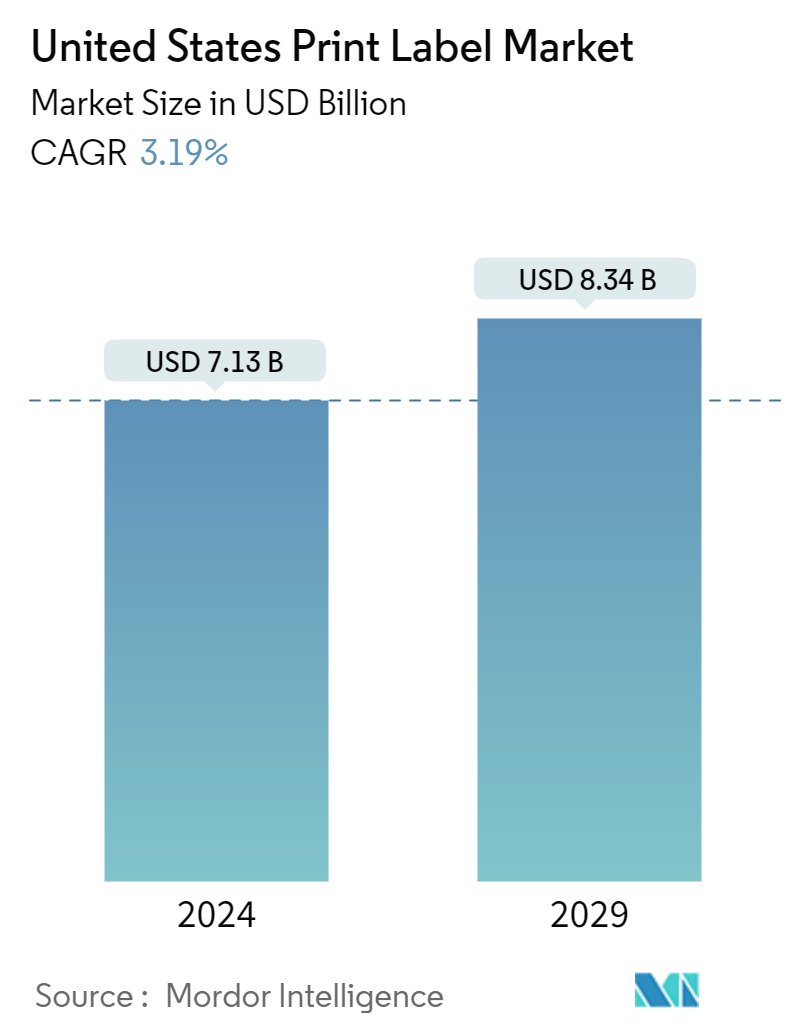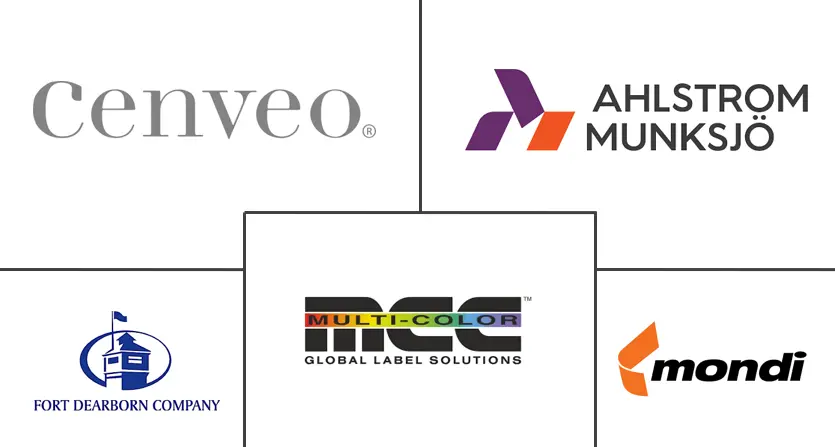Market Size of United States Print Label Industry

| Study Period | 2019 - 2029 |
| Base Year For Estimation | 2023 |
| Market Size (2024) | USD 7.13 Billion |
| Market Size (2029) | USD 8.34 Billion |
| CAGR (2024 - 2029) | 3.19 % |
| Market Concentration | Medium |
Major Players
*Disclaimer: Major Players sorted in no particular order |
United States Print Label Market Analysis
The United States Print Label Market size is estimated at USD 7.13 billion in 2024, and is expected to reach USD 8.34 billion by 2029, growing at a CAGR of 3.19% during the forecast period (2024-2029).
- The COVID pandemic has provided opportunities for digital printing in labeling. Labels are part of the supply chains of necessities. Additionally, they serve as an essential tool for conveying information. Hence, the market has witnessed an increased demand for food, hygiene, pharmaceutical labels, and labeling information related to e-commerce sales. Short runs on a regular and increasing basis have become the norm.The United States label industry played a key role in the initial month of the outbreak. The label converters in the US delivered printed products that were in high demand during the COVID-19 outbreak.
- Digital technology has met the multiple requirements of various end-user industries in developing attractive label designs to encourage potential consumers to make purchases. The integration of digital technology with the existing label printing techniques is expected to bring a massive change to all the small-scale and large-scale sectors, improving the overall market.
- Moreover, flexography printing is expected to drive the print label market in the country. With the rise in automation, customers want their products as close to the order time as possible. Faster turnaround times are becoming more vital than ever to meet demand. Flexographic printer with continuous print solutions, more software integrations into the presses and technologies, and durability would meet customer demand in shorter lead times.
- Flexography, a roll-feed high-speed printing technique, is appropriate for most packaging and label applications. The best thing about this flexography is that it makes it possible to print labels on a wide range of products quickly, affordably, and with excellent quality. A flexible printing plate creates a flexographic print by creating a three-dimensional relief of the desired image in rubber or another flexible material. Due to its excellent combination of quality, productivity, and flexibility, flexographic printing has become the most popular print generation in the print label industry.
- Print Labels is crucial in product safety and promotions through flexible packaging attributed to on-demand printing in almost any size or quantity. Advanced flexographic printing techniques enable brand owners to efficiently promote their products and transmit information about them, including their origin, crucial nutritional data, and even crucial tracking data for a product recall.
- Due to the lower cost of flexo printing, its platforms have increasingly entered the market. Creating personalized, limited-run print labeling has also grown more appealing. Flexography is a printing technique that uses a flexible (rather than a solid) plate. It is a newer incarnation of relief printing.
- Enhancing the process of label converting is a continuous and demanding task due to the difficulty in keeping pace with the latest advancements in technology. UV LED curing technology has emerged as a significant breakthrough in various printing processes. It now provides significant advantages for narrow web flexographic printing and overprint varnishing for labels, tags, flexible packaging, and shrink-sleeve packaging applications.
- Apart from enhancing printing performance, UV cured inks are migration-compliant and, hence, ideal for UV flexo food packaging and label applications. Sun Chemical recently launched SolarVerse, a range of highly pigmented, low viscosity, multipurpose UV flexo base concentrates that are ideal for labeling food materials.
- Moreover, paper film stocks tend to be less durable than films, potentially ripping or wrinkling over time if proper care is not taken during the application process. However, labeling about environmental regulation will also hinder the growth of the print label market. If a label remains on an item during recycling, it will hinder the recyclability of the item. For example, when labeled corrugated boxes are recycled, wet strength paper labels do not hinder box recycling, but if the film is used instead of wet strength paper, the label could not have been recycled.
United States Print Label Industry Segmentation
The print label is a piece of paper, plastic film, cloth, metal, or other material affixed to a container or product, on which is printed information or symbols about the product or item. There can also be information printed directly on a container or article. Moreover, print labels are the primary source of communication between a company and its customers. Labels contribute majorly to how a consumer perceives a product while looking at a product label and how much impact it makes on the consumer's mind. Various printing processes such as flexography, Gravure, Screen, among others, with different label formats such as wet-glue labels, linerless labels, among others, and end-user industries such as food and beverage, healthcare, cosmetics, industrial, among others, are analyzed as a part of the study.
The United States Print Label Market is segmented by Print Process (Offset Lithography, Gravure, Flexography, Screen, Letterpress, Electrophotography, Inkjet), Label Format (Wet-Glue Labels, Pressure-Sensitive Labels, Linerless Labels, Multi-Part Tracking Labels, In-Mold Labels, Shrink and Stretch Sleeves), End-User Industry (Food, Beverage, Healthcare, Cosmetics, Household, Industrial (Automotive, Industrial Chemicals and Consumer and Non-Consumer Durables), Logistics). The market sizes and forecasts are provided in terms of value (USD) for all the above segments.
| By Print Process | |
| Offset Lithography | |
| Gravure | |
| Flexography | |
| Screen | |
| Letterpress | |
| Electrophotography | |
| Inkjet |
| By Label Format | |
| Wet-glue Labels | |
| Pressure-sensitive Labels | |
| Linerless Labels | |
| Multi-part Tracking Labels | |
| In-mold Labels | |
| Shrink and Stretch Sleeves |
| By End-user Industry | |
| Food | |
| Beverage | |
| Healthcare | |
| Cosmetics | |
| Household | |
| Industrial (Automotive, Industrial Chemicals, and Consumer and Non-consumer Durables) | |
| Logistics | |
| Other End-user Industries |
United States Print Label Market Size Summary
The United States print label market is poised for steady growth, driven by the increasing demand for labels across various sectors such as food, hygiene, pharmaceuticals, and e-commerce. The market has seen a significant shift towards digital printing technologies, which have become essential in meeting the diverse needs of end-user industries by offering attractive and informative label designs. The integration of digital technology with traditional printing methods is expected to revolutionize both small-scale and large-scale sectors, enhancing market dynamics. Flexographic printing is anticipated to be a key driver, with advancements in automation and software integrations enabling faster turnaround times to meet rising customer demands. Strategic partnerships and investments in new technologies, such as anilox cleaning and flexo presses, further underscore the industry's commitment to innovation and efficiency.
The market landscape is characterized by a moderate concentration of players, with both large and small companies actively engaging in product innovation, strategic partnerships, and mergers and acquisitions to strengthen their market position. The beverage industry, in particular, is a significant end-user, with innovative labeling and packaging solutions driving growth. The rising demand for health drinks and the expansion of the wine market are also contributing to the increased need for label printing. Additionally, the market is moving towards sustainable solutions, with companies like Mohawk Fine Papers Inc. introducing environmentally friendly products. Despite challenges such as rising raw material costs and environmental regulations, the market is expected to continue its upward trajectory, supported by ongoing investments and strategic collaborations.
United States Print Label Market Size - Table of Contents
-
1. MARKET DYNAMICS
-
1.1 Market Overview
-
1.2 Market Drivers
-
1.2.1 Growing Demand for Labels Manufactured with Digital Print Technologies
-
1.2.2 High Adoption From Healthcare and Cosmetics Segment
-
-
1.3 Market Challenges
-
1.3.1 Lack of Products with Ability to Withstand Harsh Climatic Conditions
-
-
1.4 Industry Ecosystem Analysis
-
1.5 Industry Attractiveness - Porter's Five Forces Analysis
-
1.5.1 Threat of New Entrants
-
1.5.2 Bargaining Power of Buyers
-
1.5.3 Bargaining Power of Suppliers
-
1.5.4 Threat of Substitute Products
-
1.5.5 Intensity of Competitive Rivalry
-
-
1.6 Assessment of the Impact of COVID-19 on the US Print Label Market
-
-
2. MARKET SEGMENTATION
-
2.1 By Print Process
-
2.1.1 Offset Lithography
-
2.1.2 Gravure
-
2.1.3 Flexography
-
2.1.4 Screen
-
2.1.5 Letterpress
-
2.1.6 Electrophotography
-
2.1.7 Inkjet
-
-
2.2 By Label Format
-
2.2.1 Wet-glue Labels
-
2.2.2 Pressure-sensitive Labels
-
2.2.3 Linerless Labels
-
2.2.4 Multi-part Tracking Labels
-
2.2.5 In-mold Labels
-
2.2.6 Shrink and Stretch Sleeves
-
-
2.3 By End-user Industry
-
2.3.1 Food
-
2.3.2 Beverage
-
2.3.3 Healthcare
-
2.3.4 Cosmetics
-
2.3.5 Household
-
2.3.6 Industrial (Automotive, Industrial Chemicals, and Consumer and Non-consumer Durables)
-
2.3.7 Logistics
-
2.3.8 Other End-user Industries
-
-
United States Print Label Market Size FAQs
How big is the United States Print Label Market?
The United States Print Label Market size is expected to reach USD 7.13 billion in 2024 and grow at a CAGR of 3.19% to reach USD 8.34 billion by 2029.
What is the current United States Print Label Market size?
In 2024, the United States Print Label Market size is expected to reach USD 7.13 billion.

